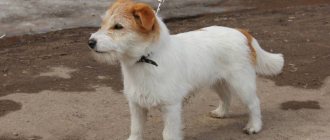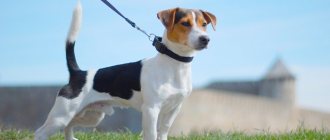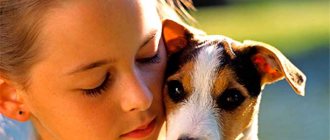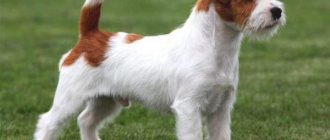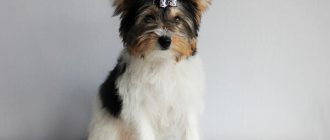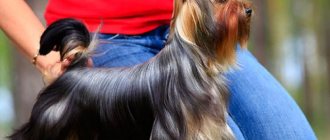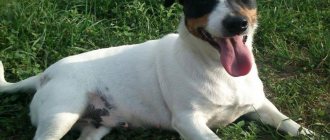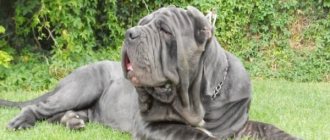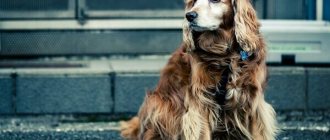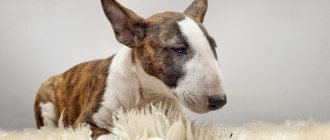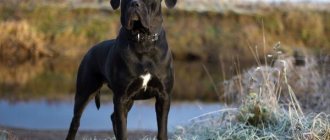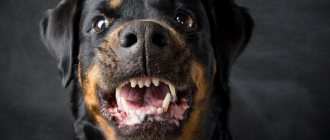If you are looking for a companion dog and have a lot of free time, then the Jack Russell Terrier is for you. This dog was bred in England to hunt burrowing animals.
The initial goal of breeding this breed was productive hunting, so the dog looked unsightly in appearance. As the breed spread and was presented at exhibitions, its appearance began to change in a positive direction.
And today representatives of the breed are harmonious, beautiful dogs.
Maintenance and care
You can keep a dog of the breed in question both in a city apartment and in a private house. However, practice shows that a pet of this breed feels more comfortable in its own home. The reasons for this are excessive activity and greater freedom during games and walks, which is allowed to pets living in country and private homes. Often, owners living in apartment buildings justify themselves by saying that the dog only needs to go out for a walk once a day.
In addition to walks, it is necessary to take the animal outside every time he wants to go to the toilet. In general, the animal adapts well to different climates; it loves to frolic in the sun in the summer and does not deny itself the pleasure of plowing through the fluffy snow in the winter. Many breeders take their dogs outside in warm clothes during the cold season. At the same time, the range of such products today is so diverse that you can easily choose an option, even taking into account the build and age of a particular pet.
From the first day of arrival in the house, the puppy should have its own place, as well as its own territory. This is a key rule of keeping, which accustoms the pet to understand the basics of upbringing. You can choose a place for the dog such that there are no drafts in its area. Also, it should not be in close proximity to heat sources (for example, you cannot “settle” a Russell Terrier by the fireplace).
The new family member should have his own dishes. In no close relationship should you make it from your own plates and bowls that are used by family members. If an animal eats and drinks from them, in the future they will be perceived as its property, which for some reason people use. There should also be no shortage of dishes: the dog should have three bowls: for dry food, liquid and water.
Care and hygiene must be regular: the animal is not able to wash and comb itself. A characteristic feature of dogs of this breed is the fact that they shed throughout the year if they are kept at home. However, wool does not cause much trouble if you get rid of dead hair on time. To comb terriers with hard hair, you need to purchase special trimmers called furminators.
These devices are convenient because, without much effort and in a short time, they can rid your pet of dead fur that prevents the growth of a new fur coat. Caring for the coat of other types of Russells is even easier: regular brushing is enough for them. As for washing, frequent water treatments are contraindicated for these dogs.
However, the lack of need for frequent bathing does not relieve the owner of the need for paw hygiene after every walk. Every time you come home, you need to wipe your dog’s paws with a damp towel or special wipes for animals. In addition, it is necessary to inspect them for cracks and wounds. In addition, we must not forget to check your pet daily for ticks and fleas that he may bring from a walk.
Ear and eye hygiene is carried out regularly. This must be done 2-3 times a month. Earwax is removed with a napkin soaked in a special product. If redness is detected in the area of the ears or eyes, the animal is immediately taken to an appointment with a veterinarian. In addition, the reasons for contacting a specialist may be discharge from the eyes and an unpleasant odor from the ears.
Dogs' teeth need to be brushed once a week. So that the pet does not resist such a procedure, it should be accustomed to it as early as possible. This should be done with special treats sold in specialized stores, as well as with the help of zoo paste and a brush for dog teeth. Pastes for people are contraindicated for dogs, as is brushing teeth with a finger with a fingertip on it.
If they stand up, this is considered a serious defect, and therefore, in order to prevent such a defect, they must be glued with a plaster. If the situation is advanced, you have to solve the problem surgically.
Feeding
The daily recommended diet is 1 to 1.5 bowls of quality dog food, divided into two servings.
However, the amount of food an adult dog needs depends on his age, size, build and activity level. Every dog is different and needs different amounts of food.
Keep Jack in good shape by measuring his diet and feeding him twice a day. If you think he is overweight, then do a little test. First, look at him. You should see his waist. Then place your palms on the back of the Jack Russell, with your thumbs along the back and your fingers along the ribs. You shouldn't see his ribs, but you should feel them with a little effort. If you do not feel them, then the dog needs additional physical activity and less food.
What the owners say: reviews about the breed
Most breeders are very happy with their choice. People note the energy of their pets, their mental abilities and their tendency to train. As a small drawback, they say that the dog needs constant attention and long walks, otherwise the Jack Russell begins to show stupid activity already in the house.
Care
Representatives of this breed are quite unpretentious in care. As mentioned above, Russells differ in the type of coat, and therefore the care of each type has its own characteristics.
Smooth-haired dogs are the easiest to care for, but they also shed more heavily than their wire-haired counterparts. The coat is brushed once a week with a coarse bristle brush. You can also use a special massage glove to improve blood circulation and relaxation. Wire-haired dogs need trimming - plucking out mature hair that does not fall out easily on its own. The procedure is quite labor-intensive and requires certain skills, so it is often entrusted to a specialist. It is recommended to carry out water procedures as needed, approximately once a month. Most of the Jack Russer Terrier's coat is white, but it always remains clean as it has the ability to self-clean.
It is also recommended to pay attention to dental health, especially if the dog eats natural food. It is necessary to provide it with special cleansing bones
You should also use a special paste and brush to clean your teeth, and this should be done at least 2 times a week. You should clean your ear several times a month. This can be done using special sanitary napkins and sticks.
Caring for puppies
Jack Russells usually give birth to 3–5 puppies in a litter, but some females give birth to 6 puppies. Newborn puppies feed on their mother's milk for the first month of life. After reaching this age, they need to gradually introduce complementary foods.
Jack Russell Terrier weight and height table by month
The age when a dog stops growing is different for each breed. Jack Russells typically grow until they are 11 to 12 months old. To properly assess your puppy's development, you need to carefully monitor its weight and height in the first year of life: use the table below for this:
| Age, months | Weight, kg | Height, cm |
| 1 | 0,7–1 | 8–9 |
| 2 | 2 | 10 |
| 3 | 2,5–3 | 11 |
| 4 | 4 | 12 |
| 5 | 4,1 | 13 |
| 6 | 4,3 | 15 |
| 7 | 4,5 | 17 |
| 8 | 4,6 | 19 |
| 9 | 4,7 | 20 |
| 10 | 4,8 | 22 |
| 11–12 | 5–6 | 25–30 |
From one and a half to 4 months, babies grow very actively, gaining height and weight, so their growing bodies require a large amount of nutritious food. If during this period the baby moved to a new home, at first it is advisable to feed the puppy the food that the breeder gave him. After the baby gets comfortable, you can change the type of feeding. If the owner chooses a natural method of feeding at this age, it is necessary to gradually introduce complementary foods into the puppies’ diet.
A 4-month-old Jack Russell Terrier continues to grow its body and internal organs. At this age, the puppy's baby teeth fall out and permanent teeth grow, and fur formation also occurs. From 4 to 6 months, the foods in the diet remain the same, but the number of feedings decreases and the volume of portions increases.
From 6 to 12 months of age, puppies grow less - at this time their bones become stronger and muscle mass increases, so the calorie content and volume of food can be reduced by reducing the amount of cereal given to the pet.
Feeding table for Jack Russell by month in the first life with a daily menu:
| Age, months | Menu for the day | Number of feedings |
| 0–1 | Mother's milk | 7–8 |
| 1–2 | Milk, soaked dry food, broth | 7 |
| 2–3 | Boiled lean meats, cereals, vegetables, fruits, dairy products | 6 |
| 4–5 | Meat, cereals, vegetables, dairy products, fruits | 4 |
| 6–12 | Meat, fish, cereals, vegetables, dairy products, boiled egg yolk, fruits | 3 |
Caring for a Jack Russell Terrier puppy from the moment it arrives in the house should be carried out according to certain rules:
- The baby’s place should be away from heat sources and drafts;
- it is necessary to purchase a sufficient number of toys for the puppy, which will be located next to his bed, as well as bowls, a leash, a muzzle, and a massage mitten;
- You can only walk your Jack Russell Terrier puppy on a leash;
- up to a year old, small Jack Russells should not go down stairs due to the risk of damage to their elbow joints;
- puppies can be walked only after they have received all the necessary vaccinations;
- you should not wake the baby unless necessary, since sleep is important for the formation of his nervous system;
- Until 5 months, Jack Russell puppies should not be left alone - at this age they find it difficult to tolerate loneliness, perceiving it as punishment.
Upbringing
Puppies strive to dominate from an early age, so it is necessary not to miss the right moment and stop trying. As soon as the baby appears on the doorstep of the house, it is necessary to teach him what is allowed to do and what is not allowed in his behavior. Especially the dog should know its place and not try to use affection and amusement to occupy the owner’s bed. Attacks, begging, and other attempts must be immediately and firmly prohibited. Parson loves to test his owner's strength and authority: having noticed compliance, he will immediately take the leading position. When traveling by car, you should not seat your dog in the front so that it does not feel its equal rights.
During walks, a representative of the breed will try to dig a flower bed, so from the first walks it is necessary to accustom the animal to etiquette; as well as from the habit of barking at other, especially large dogs - this will protect both the health and life of the terrier.
A little history or how the Jack Russell Terrier breed appeared
Jackies were originally bred to hunt small and medium-sized burrow game: badgers, foxes and various water rats, such as muskrats.
They appeared at the beginning of the 19th century and got their name thanks to the English preacher and great hunting enthusiast John Russell.
Why were the first terriers white?
Initially, all these dogs were exclusively white. Do you know why?
In the century before last, burrow hunting became very popular in England. First, the beast was driven by a fleet-footed pack of fonkhounds. And when he hid in his hole, the fearless jacks came into action.
A small but strongly built dog had to drive the fox underground, and then pull it out after a fierce fight.
And so, in order not to confuse a dog with an animal even at a distance, only white terriers were used for hunting.
Fox Terrier - the ancestor of modern Russells
At first, the appearance bore little resemblance to the modern breed. All that was required of the dogs was obedience, courage, endurance and short stature in order to feel free in the hole.
And only the most meticulous breeders paid attention to the appearance of the animal. For example, erect ears were then a sign of a defect
How is a Russell similar to a bulldog?
As a result, these dogs began to develop aggressive fighting qualities that were unusual for a hunting breed. Fortunately, these dogs later did not gain the love of either breeders or owners.
But still some light jacks with bright dark spots have the genes of those same bulldogs.
Such dogs are distinguished by an unusually wide head and a squat “bulldog” build. But their main difference is the absence of the usual “bell”: they do not have a cocky loud bark, which is simply necessary when hunting.
History of the origin of the species
The Jack Russell Terrier breed is on everyone's lips after the release of the film "The Mask".
This breed was bred in the 19th century by an English clergyman from the county of Devonshire. His name was John, but for some reason the parishioners nicknamed him Jack, hence the name of the breed. This minister was fond of fox hunting. He bred and crossed terriers of different breeds with each other in order to obtain the ideal hunting assistant.
The result is a dog that can crawl into any hole perfectly, has sharp eyesight and a sensitive sense of smell. In fact, the breed he bred is a fox terrier of especially large size.
You can recognize a Jack Russell Terrier by the following characteristics:
- The head is a large, wide skull that sharply tapers upward. The muzzle has a neat mustache and a small beard. The transition to the muzzle is very smooth;
- The eyes are almond-shaped, dark in color, deep-set;
- The ears are triangular, the ends protrude sharply forward. The ears are pressed to the head;
- The neck is long, strong, tightly pressed to the shoulders;
- Paws – The front paws are straight and parallel to each other. The knee joints on the hind legs stand out sharply. The hind legs are stronger and stronger than the front legs, the dog relies on them when jumping;
- The body is powerful, elongated, muscular. Chest girth 40 – 43 cm, chest deep-set. Convex lower back with a flat top;
- The tail is straight and needs docking. The recommended height of the tail after docking is 13 cm. During active movement of the dog, the tail rises above the level of the back.
- Wool can be of three types: hard, smooth and medium hard. The main indicator of the purity of a breed is the presence of colored spots. Solid white color is not allowed. “Liver” coloring is also not allowed. The dog must have a smooth, short undercoat.
This breed is distinguished by its great jumping ability and physical strength . Thanks to its developed hind legs, the animal can “hang in the air” for a moment while jumping, which is why this breed is often ironically called the “flying dog.”
Despite its short stature, this dog is in no way reminiscent of other small burrowing dogs, such as the dachshund or basset hound.
A long, elongated, well-built body helps the terrier easily penetrate any burrow, so it is an ideal companion for hunting hares, foxes and other burrowing animals.
The breed is one of the five most popular terriers in Russia. Thanks to its spectacular appearance, the Jack Russell Terrier, especially the wire-haired one, is a frequent guest at dog shows.
The spots on a purebred dog should be located on the head and body. They should not occupy more than half of the total body area. The spots are located in a random order; no pattern has been identified here.
If an animal has a naturally short tail, it does not need to be docked to participate in the exhibition . The main thing is that it occupies a stable vertical position, at a right angle to the back.
For amateur dog breeders who are prone to fur allergies, it is better to choose a pet with short, coarse hair, as they shed less intensely and for a short period of time.
Breed characteristics, behavioral characteristics
This breed is characterized by its small stature, which allows the animals to easily crawl into holes and move nimbly through them. Russell walks with a springy, relaxed gait, his strong paws provide him with high speed and running time in pursuit of game. Its strong jaws and strong fangs provide a reliable grip on prey, both underground, on land and on water. As mentioned above, this breed is characterized by a light or white color with dark or brown spots.
If you decide to get your own pet Russell Terrier, you will most likely find a cheerful, loyal and friendly companion. He will be happy when all your household members get together. Four-legged friends love to take walks with you for company and willingly play outdoor games with their owner. They are characterized by extraordinary activity and liveliness of nature.
Let's name a few more characteristic character traits:
- Russell is cheerful, friendly to his owners, and willingly plays with them. And he does not lose these qualities until old age. Like other small breeds (dachshund, beagle and others), with proper care, the Russell can live up to 15 years, but even in his “retirement” years he will not stop entertaining household members with his gaiety.
- This breed is brave and can behave independently, which sometimes causes difficulties in training.
- The Jack Terrier is friendly towards children and is not aggressive towards strangers - but only if it is raised properly.
- A powerful hunting instinct forces him to rush at cats and other small animals, including those he saw on the street. All these creatures are just likely prey, and the dog is able to attack them to make them prey.
- The breed is characterized by curiosity, and the boring and monotonous life of Russells is depressing. They need a rotation of vivid impressions to satisfy their interest in the world around them.
- They are distinguished by endurance and restlessness. Therefore, it is better to get a Russell not for those who prefer to lie down or live at the computer most of their free time. The best owner is a restless person or a family in which it is customary to constantly move, play, travel, and work in the fresh air. Terriers need exercise to stay healthy.
Nutrition
A natural diet should consist of the following products:
| Recommended diet | |
| Lean meat, offal (offal, liver, cartilage) | In addition to chicken meat, which causes allergies |
| Kash | Buckwheat, rolled oats, rice |
| Vegetables | Pumpkins, carrots, beets |
| Fruit | Apples |
| Fermented milk products | |
| Egg yolk |
For example, it is useful to give your pet carrot and apple salads seasoned with sour cream.
From two months you need to add to your daily diet:
- Chondroitin.
- Fish fat.
- Calcium.
You can entrust the selection of useful substances to a veterinarian. When training, the animal is encouraged a little with rye crackers, hard cheese, and dried apples. Parson is prohibited from:
- Legumes, especially corn.
- Semolina.
- Onion and garlic.
- Citrus.
- Smoked.
- Grape.
- Sweets.
- Sausage.
- Nuts.
- Mushrooms.
- Pepper.
Although Russells give the impression of being very active dogs, they should not be fed. Healthy adult dogs should eat twice a day; at 2-4 months the puppy needs to eat 5 times a day, from 6 months - 4 times, at 10-12 months - 3 times.
Training
Russells are trained depending on the purpose for which they purchased the dog. A hunting dog is raised by one set of rules, a companion by another. Hunting skills are best developed by specialists in canine organizations. This is a rather difficult process that develops in the dog courage, perseverance, and the ability to make decisions. A domestic Russell is a completely different matter. They are quite obedient, but it is forbidden to tease the dog, and you cannot use methods such as beating and screaming in training. It is best to use the incentive method.
For more information about the characteristics of this breed, see the following video.
Popular colors
The most popular color is the white-red color, which can be either with or without darkening on the face..
The tricolor, in which markings of black and red shades are scattered on a predominant white background, is also popular.
The white and black color is less common, although due to the pronounced contrast of the white background and black spots it looks simply magnificent.
Pure white color, in which the dog has a black nose, black edging of the eyelids and lips with black pigmentation, is also considered standard, but due to the ambiguous attitude of show experts towards it, it is less popular.
It is not common to see Jack Russells whose predominant color is not white, but brown or black.
These colors are considered non-standard and are a serious drawback.
And an extremely rare non-standard color is brindle, most likely inherited by Jack Russells from the old-type bulldogs with which they were crossed to improve their fighting qualities.
The right diet
Keeping jacks involves not only hygienic care, but also proper timely nutrition. A healthy diet is the key to strong bones, a strong immune system, energy and good mood.
You can feed Russells with ready-made dry food. It is convenient to store, transport, pour and easily measure the required amount. In addition, the granules contain the necessary complex of vitamins and minerals.
But low-quality dry food leads to gastrointestinal imbalance and serious health problems. Therefore, it is better to opt for super-premium products for small active breeds.
Natural nutrition should consist of raw (thawed or scalded) lean meat and complex carbohydrates. Chicken, turkey, beef, rabbit are suitable. By-products can be used. Not all Russell Terriers love fish, but you can pamper your Jack with seafood.
Allowed cereals:
- oatmeal;
- buckwheat;
- barley porridge.
Vegetables:
- carrot;
- zucchini;
- beet.
If Russell loves fermented milk products, then you can add kefir, cottage cheese, fermented baked milk, and sour cream to the diet.
One of the features of keeping Jack Russell puppies is feeding them 4–5 times a day. Up to 3 months, babies are fed 5-6 times, up to 5 months - 4 times, only by the age of one year are they transferred to two meals a day. The serving size is determined by the formula: 20 g of food per 1 kg of Russell Terrier weight.
What to feed
There are two options here. Some owners use natural food, others prefer a ready-made option. For Jack Russell, it is recommended to choose food that is premium or holistic. One of the leading companies (RoyalCanin) has developed an entire line of food specifically for this breed.
Note to the owner. Puppies need food that has high energy value, which will allow him to remain mobile and active. It is worth considering here that terriers tend to be obese, and therefore the food must be balanced in animal fats and carbohydrates. This balance is ideally maintained in holistic medicine.
If we talk about natural feeding, the approximate diet may look like this:
- meat products at least 60%. It is best to give beef, turkey, liver, kidneys;
- oatmeal and rice porridge not less than 20%;
- dairy products (curd, curdled milk, milk). You should be very careful with the latter product; your dog may be lactose intolerant;
- marine fish, raw or boiled (here you will need to choose bones);
- a variety of fruits (apples, bananas, pears).
It is important to know. Natural food should not contain seasonings, oil, sugar, dressings, or sauces. It is also recommended to avoid very sweet fruits.
In the table below you can find out in more detail how many times a day you should feed your Jack Russell.
Feeding frequency
| Age category (days) | How many times to feed per day |
| 60 – 90 | 5 |
| 90 – 180 | 4 |
| 180 — 240 | 3 |
| 240 — 300 | 2 |
Breed characteristics
| Short description | |
| Origin: | Great Britain |
| Conditions of detention: | In an apartment/in a house |
| Purpose: | Mainly a working hunting dog, with proper training can be successfully used as a companion dog |
| Color: | White, red, yellow or black spots allowed, mainly on the head or tail |
| Wool length: | Short, less than 5 cm, bristly, with undercoat |
| Adult dog size: | Weight: 6-8 kg Height: 33-36 cm |
| Average life expectancy: | 13-15 years old |
| Walk: | Long walks required, 2-3 times a day |
| Physical activity needs: | High, requires daily, active games lasting at least 1 hour with high intensity |
| Fédération Cynologique Internationale (FIC) classification: | Recognized by the FCI in 2001 Group 3. Terriers/Section 1. Large and medium terriers |
| Puppy price: | Without breeding rights - 15-25 thousand rubles For exhibitions and mating - 35-45 thousand rubles |
What you need to know about the breed standard
Modern representatives of the breed have a white coat, which should have red or black markings. Red spots may have different shades. The dogs are smooth-haired. The texture may be hard or ridged. The coat provides excellent protection for the terrier in adverse weather conditions.
The chest is quite deep, but not very wide. This important parameter is indispensable in burrow work. The body is flexible. While the animal is moving, the tail is in a standing position. Some breeders use docking.
The ideal height of an adult dog is 25 – 30 cm. Hunters have a flat skull, a clear transition from the frontal part to the muzzle. There is also a narrowing of the muzzle towards the oral cavity.
Interesting point. Despite its unprepossessing appearance, the Jack Russell came to the attention of film directors, where it gained justifiable fame. Here it must be said that dogs may look cute, funny, smart and obedient from screens, but they acquire such qualities only with early socialization and competent educational work. Otherwise, the pet will cause its owner a lot of problems.
Character traits
If we compare representatives of this breed with other terriers, the former have a significant difference in the form of balanced behavior. They often cuddle up to their owner, rarely raise their voices, but they are very willing to learn and are ready to follow a person anywhere. Unpretentiousness and endurance are also characteristic of Jack Russells.
If there is sufficient physical activity, the owner will not have any problems with his pet. It is worth considering that the dog is quite independent and has a decisive character. They also enjoy taking part in various games.
Positive results in training can only be achieved through patience and perseverance.
If there are children in the house, the terrier will be very friendly towards them. Especially in cases where they live together from an early age. A dog can be aggressive towards members of its own species. To avoid this, it is necessary to carry out socialization at the earliest possible stages.
The hunting instincts of Jack Russells have not gone away, and therefore if there are also small pets in the house, then, in most cases, conflict situations arise. This especially applies to rabbits and decorative rodents; cats can also suffer.
This breed needs to be constantly occupied with something. When a four-legged pet begins to feel bored, it will begin to cause damage to the home interior:
- chews household items;
- digs floors;
- voices often;
- begins to demonstrate uncontrollable behavior.
Jack Russells require constant training, and it is also recommended to enroll dogs in various competitions.
Some owners make the mistake (due to the small size of the dog) and believe that the terrier will make an excellent indoor dog. Here everything will come down to hunting instincts, the animal will show curiosity and activity. Older people often cannot cope with such dogs, and therefore it is worth carefully weighing the pros and cons when choosing a Jack Russell.
If you miss raising your pet, then it will be inappropriate for him to show his independence. Terriers have a rather wary attitude towards strangers, but they show aggression towards their own kind. Chasing cats is a favorite activity, so when walking, it is recommended not to let the dog off the leash; you can give free rein to your pet in a quiet and familiar place.
If there are two terriers in the same apartment, they should not be left together. The showdown will begin immediately. Due to their hot temper, Jack Russells are jealous of their territory, and generally consider their owner to be their property.
The energy of dogs is evident in everything; a short and uninteresting walk will lead to the fact that at home the pet will find entertainment in the form of encroaching on the integrity of the owner’s things. When keeping in a country house, it is worth taking into account the jumping ability of small hunters; rather high fences will not always become a hindrance for them. If it is not possible to jump over, the terrier will be happy to dig under the ground.
A dog should not be left without education; representatives of this breed need intellectual stimulation. A lively mind allows pets to learn easily, but sometimes they begin to be stubborn. It is recommended to alternate commands, and do not forget about positive reinforcement in case of successful execution of the order.
How much does a puppy cost and how to choose one?
If you turn to reputable breeders, you will have to pay 35,000 - 45,000 rubles. If there are parents with a large number of titles, the price increases to 80,000 rubles. Puppies that do not have a pedigree can cost 10,000 – 15,000 rubles.
Important! It is worth refusing the offer if they ask for less than 10,000 for a dog; there is a high probability of purchasing a pet with a bunch of diseases or some deviations from the breed standard.
When choosing a grown animal, you will have to shell out about 25,000 rubles, but at the same time you will have to pay a round sum for the services of a professional dog handler.
Today, Jack Russells are not very popular in Russia, which means the choice of kennel where to get a dog is quite limited.
If there is no preference for a specific breeder, then it is recommended to visit an exhibition where representatives of this breed will take part. Here you can talk to the owners of such dogs and get the coordinates of the kennel you like. The upbringing of the puppy and its further social adaptation in the new place of residence depend on the correct choice.
Parson Russell Terrier breed standard
Parson Russells are very similar to Jack Russell Terriers, which is no coincidence - the breeds have common ancestors, and until 2001 they generally had to share one standard of appearance between two. And yet there are exterior differences between representatives of both families. For example, Parsons are slightly taller than Jacks and have an almost square body shape, while their counterparts have a distinctly rectangular body. Leg length is also considered a breed characteristic. Parson Russell Terriers have longer limbs than the stocky, compact Jack Russells.
Eyes
Parson Russell Terriers are characterized by deep-set, almond-shaped eyes with dark-colored irises. The dog's gaze is inquisitive and soulful.
Ears
The ear flap is small, perfectly triangular in shape, hanging forward. The tips of the ears almost touch the outer corners of the eyes.
Neck
The neck of a purebred individual should be muscular and gradually widen towards the shoulder girdle. The pronounced massiveness of this part of the body is not welcome.
Frame
The Parson Russell Terrier has an almost square body with a strong back, a slightly convex loin and a normal chest depth, located above or at the level of the dog's elbows.
The Parson Russell's front legs are straight, strong, with long shoulder blades pointing back and elbows tightly pressed to the body. The hind legs are muscular and well angulated, with the hock joints located very low. The animal moves sweepingly, freely, energetically.
Tail
Working Parson Russell Terriers have their tails docked, so this part of the body can only be viewed in its natural form on show dogs (canine associations in Europe have vetoed the docking procedure). A natural tail should be perfectly straight, powerful, set relatively high, and held vertically when moving. The docked tail should not be too short so that, if necessary, the owner can grab it with his hand, removing the carried away pet from the fox hole.
Wool
The Parson Russell Terrier can be either slightly shaggy or smooth-haired. The coat itself is coarse and thick, which is a necessary condition for hunting breeds - a dense layer of hair protects the dog’s body from bites and scratches of wild animals.
Color
Parson Russells are either completely white or white with red, black and yellow spots. Moreover, it is preferable if the spots are located on the head or at the base of the tail.
Defects and disqualifying defects
Individuals whose appearance does not fit into the framework specified by the standard are considered defective. In particular, dogs with an incomplete set of teeth, incorrect structure of the body and paws, as well as with a light-colored iris will be rejected by the show judges or will receive a low score. Animals with an unstable psyche, as well as Parson Russells with too conspicuous defects in appearance, indicating a dubious pedigree, are subject to complete disqualification.
Read with this
- Without unnecessary noise
- Parson Russell Terrier
- How to toilet train a dog using a diaper
- Can your dog swim? Why Some Dog Breeds Can't Swim - Tips for Pets - 2020
- How to sew a blanket for a dog with your own hands
- Operant method of dog training
- The best dog breeds suitable for older people
- How to transport a dog on a train? new rules of Russian Railways on the transportation of animals
- Puppy Development Stages with Growth Charts and Weekly Week - Puppy Project
- We learn to determine the health status of a pet by the temperature of its nose
The breed is prone to diseases
The Jack Russell Terrier is a disease-resistant breed, but there are a number of diseases that are constant for its representatives.
These include:
- hip dysplasia;
- congenital deafness;
- eye abnormalities;
- pathology of the femoral head.
Having this breed as a pet, you should not neglect examinations of the animal by a veterinarian to assess the general condition and timely violations.
